

Before the Wall: Life Along the U.S.-Mexico Border. Log In Don't have an account?

Sign up here » Facebook. Superblocks: Barcelona's war on cars. Placemaking Blog - Project for Public Spaces. In Global Megacities, Life is a Kaleidoscope of Stories. This story appears in the March 2017 issue of National Geographic magazine.
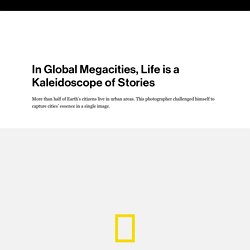
More people live in cities than ever before. According to the United Nations Population Fund, over half of the world’s citizens now live in an urban area—a figure expected to reach nearly 70 percent by 2050. Globally, one in eight of those city dwellers lives in a megacity, defined by the UN as a place with more than 10 million people. Beirut's last public beach: residents fear privatisation of Ramlet al-Baida. Take a stroll down the golden sands of Ramlet al-Baida, Beirut’s last public beach, and you’ll see families fishing and smoking shisha in ramshackle palm frond cabanas, boys kicking footballs under battered lamp-posts, and children building sandcastles in the waves.
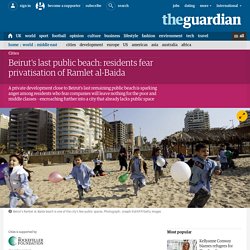
It is a rare outlet in a city where public spaces are few and far between. But at the beach’s southern end, the scene abruptly gives way to looming cranes and men in hard hats driving rebars into a rising edifice of concrete. The development, known as the Eden Bay resort – a more than 5,000 sq metre project billed by its website as “a sanctuary of luxury and refinement” – began construction last year, sparking outrage among beachgoers, civil society activists and public space advocates.
Garbage City: The scavengers making a fortune from other people's rubbish. Image copyright Alamy Despite the growing intolerance Copts face in Egypt, they are finding great success in the country's recycling business. The Tibetan nomad traditions defying the modern world. Despite decades of change and development, nomads still migrate to the Tibetan Plateau every summer, from where China Correspondent Stephen McDonell reports.
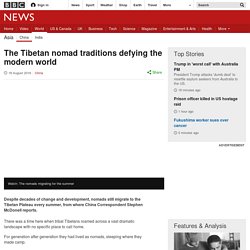
There was a time here when tribal Tibetans roamed across a vast dramatic landscape with no specific place to call home. For generation after generation they had lived as nomads, sleeping where they made camp. They kept their livestock moving, chasing the fresh pastures that became available as the seasons changed. The limits of their territory were identified by mountains and rivers, and their nomadic existence permeated all aspects of their culture.
In 2016, you might expect this lifestyle to have been fully extinguished, yet it hasn't been. Explicit cookie consent. Face-off over the Congo: the long rivalry between Kinshasa and Brazzaville. Sunday morning, and the crowds are thronging the myriad churches on the ragged western edge of Kinshasa.
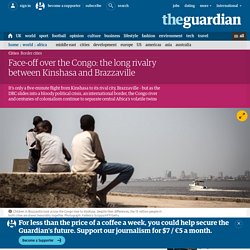
Congregations file into the barn-like halls to hear priests and preachers. Down on the terrace of Chez Tintin, one of Kinshasa’s best known restaurants and nightspots, only fishermen and two tourists from the central town of Kisangani brave the warm, driving rain. Beyond the plastic tables and chairs, a low brick wall, and the pilgrims, is the Congo. Though 4,500km from its furthest source, the great river is less than 1,000 metres wide at this point, and surges through the narrow bottleneck with tremendous power. Who lives here now? Park Hill. The giant concrete estate of Park Hill in Sheffield started life as a bustling new home for council tenants in the 1960s.
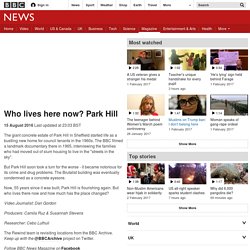
The BBC filmed a landmark documentary there in 1965, interviewing the families who had moved out of slum housing to live in the "streets in the sky". But Park Hill soon took a turn for the worse - it became notorious for its crime and drug problems. The Brutalist building was eventually condemned as a concrete eyesore. Now, 55 years since it was built, Park Hill is flourishing again. On Scottish Islands, a Generation Caught Between Past and Future. A quick online search of the Western Isles, also known as the Outer Hebrides, reveals no shortage of dreamy imagery.

The region, west of the Scottish mainland, is branded by travel agencies as an otherworldly paradise with untamed shorelines under vast, open sky. It is one of the few places where Scottish Gaelic is still dominant. Given this reputation, it took French photographer Laetitia Vancon by surprise when she read The Stornoway Way, an autobiographical novel by Scottish writer Kevin McNeil. Kenya's slum DJ shows us around Kibera. Abdullah 'Dallas' Mussa has been working as a journalist and local radio DJ in Nairobi's Kibera slum for more than two decades.

With a population of more than 200,000, the slum is considered Kenya's biggest and Dallas has a lot of ground to cover. Mood swings: The man mapping Britain's emotions. Image copyright Daniel Raven-Ellison National Geographic explorer Daniel Raven-Ellison has just completed a 2.5 million step walk across Britain's cities and parks and electronically measured his changing mood with each step.

Wearing an EEG monitor strapped to his head he collected millions of snapshots of the activity in his brain as he crossed 69 cities over seven months in the UK from June last year. The monitor measures the electrical activity of the brain from sensors located across key areas of the scalp. Its software provided metrics on how stressed, relaxed, excited, focused, interested and engaged he was during his walks. Inside Regent Park: Toronto's test case for public-private gentrification. Paintbox Bistro is a typical modern restaurant: high ceilings, framed art and hand-built wooden tables, serving everything from snacks to wraps to flank steak by a chef who did time in trendy Toronto eateries.
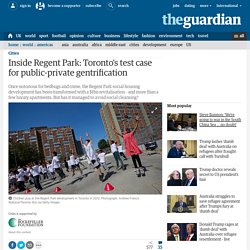
It’s a description that could apply to many of the restaurants that regularly pop up (and back down) throughout Canada’s foodie capital. Except Paintbox Bistro has a twist: it is located in what used to be the city’s roughest neighbourhood, Regent Park. A 69-acre housing project known for bedbugs and crime, Regent Park became especially notorious in 2005, when a member of the Point Blank Soulijahs gang – an offshoot of the Regent Park Crew – shot dead a 15-year-old bystander near the Eaton Centre, the biggest mall in the downtown core. The killing shocked Toronto; several years later, in 2012, fighting between the gang’s descendants, the Sic Thugz, led to another weekend shootout.
“It took us five years to refine the model,” says Chris Klugman from Paintbox Bistro. The experiment. “Whose Streets, Our Streets”: Democracy Still Lives in Public Spaces - Project for Public Spaces. “When public space is eroded, our civic culture suffers, even our democracy.” – Richard Rodgers Union Square in New York City has played a central role in symbolizing democracy, serving as a place for democratic action from the time of the Civil War. This image shows a crowd gathered in Union Square during the May Day parade in 1913 | Image from Flickr Commons project, 2009 Regardless of how you feel about the 2016 U.S. election results, one thing is clear: public spaces are doing their job.
This past week protests arose in New York, Los Angeles, San Francisco, Oakland, Portland, Seattle, Chicago, in smaller cities around the U.S. such as Pittsburgh and Salt Lake City, and also around the world in cities like Berlin, London, and even Marrakech, in response to the election of Donald J. Trump who will become the nation’s 45th president next January. Segregation at 'worrying levels' in parts of Britain, Dame Louise Casey warns. Image copyright Alamy Segregation and social exclusion are at "worrying levels" and are fuelling inequality in some areas of Britain, a report has found. Women in some communities are denied "even their basic rights as British residents", the Casey Review said.
Dame Louise Casey accused public bodies of ignoring or condoning divisive or harmful religious practices for fear of being called racist. Architecture of Place: Buildings that Work for People. Some may be surprised to hear PPS echoing a version of the modernist mantra “form ever follows function” (see principle 9), but it’s important for us to remember what that phrase is really all about. When it was first coined by Louis Sullivan, it was a humanist idea: that the form of a building should serve first and foremost the human uses that animate it. But over time, as Jane Jacobs observed, the idea of function underwent a “drift from humanism to gimmickry.” The art of gentrification: city data made beautiful. Trees may increase air pollution on city streets. City trees, popularly thought to remove pollutants and improve urban life, may also increase the amount of foul air that people breathe, says the UK body which gives independent health guidance to national and local government.
“Leaves and branches slow air currents, causing pollutants to settle. They may also act as sinks for particulates and chemicals that may have direct or indirect effects in air quality. Air quality [under trees] may deteriorate at street level near vehicles,” says the National Institute for Health and Care Excellence (Nice) in new draft guidance for local government to combat air pollution. Nice does not recommend that councils cut down trees in leafy suburbs to meet pollution limits, but urges planners, local authorities and developers to take into account the adverse effect that trees can have on air quality if badly sited or unmanaged. “It is not always true that trees reduce air pollution. “Past measures have not had the required impact. A tour through London with the city's homeless. London, England - Although originally from Bergen in Norway, Viv Askeland has lived in London since 1979. Placemaking As An Antidote to Sprawl - Project for Public Spaces.
Published June 1st 2002. Does Middlesbrough deserve its unenviable reputation? Middlesbrough, an industrial town on England's north-east coast, gets a bad press. From 1940s Baghdad to 1980s Newcastle: an archive of urban change – in pictures. Modern Malta: Old and New Collide on This Island Nation. Database helps plant 'right tree for the right place' German researchers have compiled a 400-species database to encourage people to plant the "right tree in the right place" in urban areas. Uncool Camden: will redevelopment ruin London's legendary market? City Talks: Is gentrification a bad thing? On this month’s City Talks, Andrew begins with a brief look at the upcoming Autumn Statement with colleagues from the Centre. Chief Executive Alexandra Jones gives her best guess on what kind of tone Philip Hammond will set, and Principal Economist Paul Swinney wonders whether further devolution packages will wait until after the Mayoral elections next year.
After that Andrew dives into the gentrification debate with author and journalist Anna Minton, Shelter’s Head of Policy Toby Lloyd, and the Centre’s very own Ed Clarke, who’s recent blog on the issue spurred a lot of discussion on Twitter. Half UK budget deficit 'is down to job destruction in older industrial areas' McDonald's sues Florence for 18m euros for blocking restaurant. Image copyright Getty Images. Technology Brings People Together in Public Spaces After All - Project for Public Spaces. Bryant Park 1980 | Image copyright Project for Public Spaces. The Positive Impact of Busking on Cities - The Busking Project. Tomorrow We Disappear: New Delhi's Kathputli Slum. London's East End is now the creative epicentre of the city. This Remote Pakistani Village Is Nothing Like You’d Expect.
Why aren’t we designing cities that work for women, not just men? How should we plan the cities of tomorrow? Census - Office for National Statistics. Local statistics - Office for National Statistics. Placemaking Resource. Prince's Foundation for Building Community. Home - Project for Public Spaces. The Greek Crisis. RTPII Policy Paper - Poverty, place and inequality. A Thriving Future of Places: Placemaking as the New Urban Agenda - Project for Public Spaces. In pictures: How a rebel fighter became 'Syria's Banksy' The importance of urban forests: why money really does grow on trees. New approaches to gentrification. Eight Placemaking Principles for Innovation Districts. Ruined by ‘locusts’: the Moscow area that got too cool, too quickly. Streets without shops: how apps are transforming our local neighbourhoods. 'No bling in the hood ...' Does Berlin's anti-gentrification law really work?
'Regeneration should be for all': will change in Johannesburg benefit its poorest residents? Not for faint-hearted: Urban explorer's highs and lows. We’d smile more! UK City of Culture: Why 2017 will change Hull for the better. In Cranes’ Shadow, Los Angeles Strains to See a Future With Less Sprawl. Green spaces worth £2.2bn to public health in England. Kinshasa's street children tell their stories on radio - News from Al Jazeera. Equity and Inclusion: Getting Down to the Heart of Placemaking - Project for Public Spaces. Regenerating Urban Land: A Practitioner's Guide to Leveraging Private Investment. The gentrification of Washington DC: how my city changed its colours. Safer Cities for Women and Girls through a Place-based Approach - Project for Public Spaces. Equitable Placemaking: Not the End, but the Means - Project for Public Spaces. How Adelaide revitalized itself through ‘placemaking’, via @Citiscope. Superblocks: how Barcelona is taking city streets back from cars.
50 Reasons Why Everyone Should Want More Walkable Streets. Zanzibar is crumbling. Meet the artisans trying to save it. Luis Silva: Being Panfilo. GeoForm for viewing My Favourite Place data. My Favourite Place. The genius loci. Who lives here now? Park Hill. Placecheck - Placecheck is a method of taking the first steps in deciding how to improve an area.
8 Lessons to Promote Diversity in Public Places - Project for Public Spaces. Putting People First: 10 Steps Toward Pedestrian-Friendly Suburbs. Changing places. The Place Game: How We Make the Community the Expert.